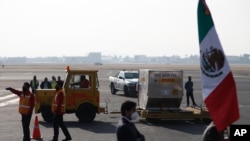Latin America received its first doses of COVID-19 vaccine on Wednesday, with a shipment landing in Mexico City.
Mexico’s Foreign Secretary Marcelo Ebrard was on hand when the flight carrying the Pfizer-BioNTech vaccine landed from Belgium.
"Today is the beginning of the end of that pandemic," Ebrard said.
Mexico is scheduled to receive 1.4 million doses of the Pfizer-BioNTech vaccine. Officials on Wednesday did not say how large the shipment was, however, but said they planned to begin vaccinating health workers in Mexico City and Saltillo, in Mexico’s north, on Thursday.
Other Latin American countries are expecting vaccine shipments or, as Argentina did on Wednesday, approving vaccines for use in their countries.
Also Wednesday, researchers found that people who had contracted COVID-19, the disease caused by the coronavirus, were much less likely to test positive again. Those people who developed antibodies were “at much lower risk” to get the disease again, and could remain virus free for up to six months or longer, the two studies found.
Dr. Ned Sharpless, director of the U.S. National Cancer Institute, which conducted one of the studies, told the Associated Press that people who develop antibodies from natural infections develop “the same kind of protection you’d get from an effective vaccine. ... It’s very, very rare” to get reinfected.
The National Cancer Institute study involved more than 3 million people who had antibody tests. The NCI study found that only 0.3% of those who had antibodies later tested positive for the coronavirus, compared with 3% who lacked such antibodies, the AP reported.
The second study, published Wednesday by the New England Journal of Medicine, involved a much smaller group. It followed 12,500 health workers, 1,265 of whom had coronavirus antibodies at the start. The study found that only two health workers tested positive in the following six months, and neither person developed symptoms, AP reported.
U.S. Army General Gustave Perna, Operation Warp Speed chief operating officer, said Wednesday that the U.S. government would distribute nearly 4.7 million doses of the Pfizer-BioNTech and Moderna COVID-19 vaccines next week.
By the end of the first week of January, Perna said, about 20 million vaccine doses will have been delivered throughout the United States.
U.S. Operation Warp Speed chief adviser Dr. Moncef Slaoui warned, however, that it would take longer to administer the doses.
"The commitment that we can make is to make vaccine doses available," Slaoui said during a press call. "How fast the ramp-up of immunizations, the shots in arms, is happening is slower than we thought it would be."
Public data show that health care workers in the United States have received about 1 million shots so far, a small fraction of the total shipped. U.S. officials said there was a lag in vaccination data of several days, however.
Chile’s Santiago international airport is employing sniffer dogs in detecting travelers with COVID-19.
A team of golden retrievers and Labradors wear green “biodector” jackets adorned with red crosses.
Passengers will be required to wipe their necks and wrists with gauze pads. Once placed in glass containers, the dogs, who have been trained to detect the coronavirus, will give a sniff.
Dogs are being used in airports in the United Arab Emirates and Finland. A recent study found dogs can identify individuals who have COVID-19 with 85% to 100% accuracy.
Chile's Carabinero police trained the dogs.









